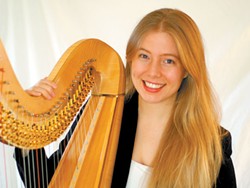“Because [the harp] is so beautiful — angels playing glissandos on a cloud in heaven — people think it’s not that hard. But in actuality, it’s incredibly hard. It takes much coordination — your feet are going on the pedals, your hands.... It’s a full-body instrument.”
Earecka Tregenza knows all about such intricacies. As principal harpist for the Spokane Symphony Orchestra, she plays on a Lyon & Healy (“widely considered to make the best harps in the world”) — the Salzedo model, in particular, named for Carlos Salzedo (the harp’s greatest innovator), who taught Alice Chalifoux (one of its greatest teachers), who taught Yolanda Kondonassis (this weekend’s soloist in the concerto by Alberto Ginastera), who taught Tregenza (whose own Salzedo harp Kondonassis will be performing upon).
That’s a lot of harp heritage in just one concerto. It’s a tradition that Tregenza honors by spending countless hours with her harp’s 47 strings (variously made of nylon, gut, or silk and steel wire) and its seven foot pedals (each with three notches, for controlling natural, flat and sharp notes).
“The harp runs a huge gamut — its tonal range is enormous,” Tregenza says. And the instrument itself, she says, is “so beautiful to look at. You gotta go see one [being played]. It’s almost like watching a dance, with the gestures — and if you can see the feet, that’ll blow your mind.”
Well, we’re in luck: On Sunday afternoon, Tregenza will give a pre-concert demo of harp techniques, with emphasis on some of the special effects that Ginastera called for in his harp concerto (which premiered in 1965).
Since the important works for harp written by Claude Debussy and Maurice Ravel a century ago, “lots of composers have written harp concertos, but none has had the staying power of the Ginastera,” Tregenza says. “I love the end of the first movement — it’s full of fire and passion and energy, and then at the end, it becomes tranquil and ethereally beautiful.”
Ginastera’s concerto displays harp fireworks. “He calls for different kinds of glissandos,” Tregenza says, using the term for a strummed series of notes played rapidly. “Some are played with your fingertips, some with your fingernails — some are played so quickly that they sound like huge chords.”
And then there are the harmonics, in which the harpist quickly pinches a string at its exact midpoint and plucks it with her thumb. “It produces a bell-like, ghostly sound,” Tregenza says.
Angels sitting on puffy clouds don’t sound as haunting as that.
The Spokane Symphony Orchestra performs music of Kodaly, Ginastera and Schumann at the Fox on Saturday, Nov. 21, at 8 pm and on Sunday, Nov. 22, at 3 pm (with pre-concert harp demonstration from 2-2:30 pm). Tickets: $22-$44. Visit spokanesymphony.org or call 624-1200 or 325-SEAT.


